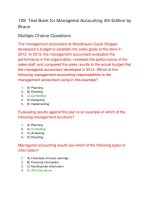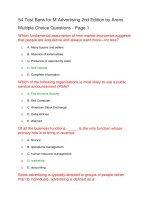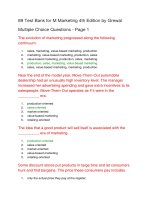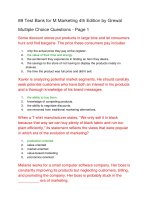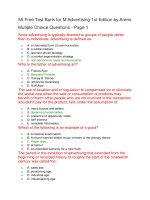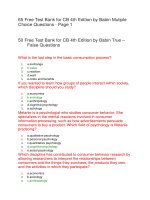Test bank for gerontologic nursing 4th edition by meiner
Bạn đang xem bản rút gọn của tài liệu. Xem và tải ngay bản đầy đủ của tài liệu tại đây (47.02 KB, 4 trang )
buy this full document at
Meiner: Gerontologic Nursing, 4th Edition
Chapter 1: Overview of Gerontologic Nursing
Test Bank
MULTIPLE CHOICE
1. In 2010, the revised Standards and Scope of Gerontological Nursing Practice was published.
The nurse would use these standards to:
a. promote the practice of gerontologic nursing practice within the acute care setting.
b. define the concepts and dimensions of gerontologic nursing practice.
c. elevate the practice of gerontologic nursing.
d. incorporate suggested interventions from others who practice gerontologic nursing.
ANS: d
The current publishing of the Standards and Scope of Gerontological Nursing Practice in 2010
incorporates the input of gerontologic nurses from across the United States.
DIF: Apply (Application)
OBJ: Nursing Process: Implementation
MSC: Safe and Effective Care Environment
TOP: NA
REF: p. 2
2. When attempting to minimize the affect of ageism on the practice nursing of the older adult
population, a nurse needs to first:
a. recognize that nurses must act as advocates for aging clients.
b. accept that this population represents a substantial portion of those requiring nursing care.
c. self-reflect and formulate one’s personal view of aging and the older client.
d. recognize ageism as a form of bigotry shared by many Americans.
ANS: c
Ageism is an ever-increasing prejudicial view of the effects of the aging process and of the older
population as a whole. With nurses being members of a society holding such views, it is critical
that the individual nurse self-reflect on personal feelings and determine whether such feelings
will affect the nursing care that he or she provides to the aging client.
DIF: Apply (Application)
OBJ: Integrated Process: Caring
MSC: Safe and Effective Care Environment
TOP: NA
REF: p. 11
3. When discussing factors that have helped to increase the number of healthy, independent
older Americans, the nurse includes the importance of:
a. increased availability of in-home care services.
b. government support of retired citizens.
buy this full document at
Full file at />c. effective antibiotic therapies.
d. the development of life-extending therapies.
ANS: c
The health and ultimate autonomy of older Americans has been positively impacted by the
development and administration of antibiotics, resulting in the management of many otherwise
life-altering diseases.
DIF: Apply (Application)
OBJ: Nursing Process: Implementation
MSC: Health Promotion and Maintenance
TOP: NA
REF: p. 6
4. Based on current data, when arranging to present an older adult’s discharge teaching plan, the
nurse includes the client’s:
a. nonrelated caretaker.
b. paid caregiver.
c. family member.
d. intuitional representative.
ANS: c
Less than 5% of older adults live in a formal health care environment. The majority of the
geriatric population lives at home or with family members.
DIF: Apply (Application)
OBJ: Nursing Process: Planning
MSC: Safe and Effective Care Environment
TOP: NA
REF: p. 6
5. The nurse planning care for an older adult who has recently been diagnosed with rheumatoid
arthritis views the priority criterion for continued independence to be the client’s:
a. age.
b. financial status.
c. gender.
d. functional status.
ANS: d
Maintaining the functional status of older adults may avert the onset of physical frailty and
cognitive impairment, two conditions that increase the likelihood of institutionalization.
DIF: Apply (Application)
OBJ: Nursing Process: Planning
MSC: Physiological Integrity
TOP: Skeletal
REF: p. 8
Copyright © 2011, 2006, 2000, 1996 by Mosby, Inc., an affiliate of Elsevier Inc. All rights reserved.
Full file at />6. A nurse working with the older adult population is most likely to assess a need for a financial
social service’s referral for a(n):
a. White male.
b. Black female.
c. Hispanic male.
d. Oriental female.
ANS: b
The poverty rate among older black women is substantially higher than that seen among males or
females of other ethnic groups.
DIF: Apply (Application)
OBJ: Nursing Process: Assessment
MSC: Safe and Effective Care Environment
TOP: NA
REF: p. 7
7. Which of the following statements made by a nurse preparing to complete a health
assessment and history on an older client reflects an understanding of the general health
status of this population?
a. “I’ll need to document well regarding the medications the client is currently prescribed.”
b. “I am particularly interested in knowing how supportive the client’s family members are.”
c. “Most older clients are being treated for a variety of chronic health care issues.”
d. “It will be interesting to see whether this client sees herself as being healthy.”
ANS: d
It is a misconception that old age is synonymous with disease and illness. The nurse should
always determine the client’s sense of wellness and independence when conducting a health and
history assessment.
DIF: Analysis (Analyze)
OBJ: Nursing Process: Assessment
MSC: Safe and Effective Care Environment
TOP: NA
REF: p. 8
8. The nurse is caring for an older adult who has been admitted to an acute care hospital for
treatment of a fractured femur. The nurse’s best response to the family’s concern about the
client’s planned transfer to a subacute care facility is:
a. “Acute care facilities generally lack the long-term physical therapy support your dad
requires.”
b. “Your dad will be much happier being in a more serene, private environment.”
c. “This new facility will focus on helping your dad maintain his independence.”
d. “Insurance including Medicare will cover only a limited amount of time here.”
ANS: c
Copyright © 2011, 2006, 2000, 1996 by Mosby, Inc., an affiliate of Elsevier Inc. All rights reserved.
Full file at />The transfer of the client to a subacute facility is based on the need to maintain the client’s level
of function and independence; a task the acute care facility is not prepared to address once the
client is physiologically stable.
DIF: Apply (Application)
OBJ: Nursing Process: Implementation
MSC: Health Promotion and Maintenance
TOP: NA
REF: p. 9
9. In order to best assure both the quality of care and the safety of the older adult client who
requires in-home unlicensed assistive personal (UAP) assistance, the geriatric nurse:
a. evaluates the competency of the UAP staff.
b. assumes the roles of case manager and client advocate.
c. arranges for the needed UAP provided services.
d. assesses the client for functional limitations.
ANS: a
As more care traditionally provided by professional nurses is being transferred to UAP, the nurse
must assume more responsibility for the educating, training, and evaluation of UAP staff
competency to provide safe, effective care for the older adult client.
DIF: Apply (Application)
OBJ: Nursing Process: Planning
MSC: Safe and Effective Care Environment
TOP: NA
REF: p. 11
MULTIPLE RESPONSE
1. The clinic nurse caring for an older diabetic client with a sixth grade education anticipates
that the client may experience difficulty (select all that apply):
a. recognizing the importance of keeping clinic appointments.
b. following a low-carbohydrate diet.
c. paying for insulin and syringes.
d. deciding on a primary health care provider.
e. naming a health care surrogate.
ANS: a, b, c
Even though the educational level of the older population has steadily increased, as a population
they are less educated than the general population. This deficiency can account for a lack of
understanding regarding the need for medical care, the importance of following a treatment plan,
and fewer financial resources to devote to health care issues.
DIF: Analyze (Analysis)
OBJ: Nursing Process: Assessment
MSC: Safe and Effective Care Environment
TOP: Endocrine
REF: p. 7
Copyright © 2011, 2006, 2000, 1996 by Mosby, Inc., an affiliate of Elsevier Inc. All rights reserved.

